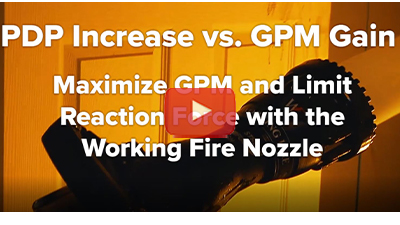Working Fire Nozzle: Maximizing GPM and Minimizing Reaction Force
If you need more GPM from your nozzle, you over pump to get there. But, how much do you have to over pump to reach the flow rate that you want?
In this video, Pods compares the Working Fire nozzle with pressure relief to a standard 150 at 75 fixed flow nozzle.
Working Fire Fixed Flow Nozzle with Pressure Relief
The Working Fire nozzle is unique due to its pressure relief feature. This exclusive feature maximizes GPM (Gallons Per Minute) when you over pump the nozzle. That same pressure relief feature keeps reaction force manageable as your GPM increases. Under similar conditions, a standard nozzle would build nozzle pressure and reaction force, but the Working Fire maximizes your GPM while keeping that pressure at a manageable level.
The Setup
In this nozzle comparison, we have 200 feet of 1.75” hose line coming off the side discharge of the fire engine. In that setup, there is an integrated SHO-FLOW flow meter so we can see flow rates in real time.
The Working Fire Nozzle
With the Working Fire 150 at 75 fixed nozzle with pressure relief, the pump discharge pressure (PDP) is about 120 psi while flowing roughly 150 gallons per minute (GPM). If you wanted to over pump the nozzle to deliver 200 GPM, you need to increase the PDP to about 180 psi. That is a 60 psi increase to achieve the 50 GPM flow increase desired.
Now, let’s see how that compares to a standard fixed flow nozzle.
Standard 150 at 75 Fixed Flow Nozzle
As expected, the PDP to flow 150 GPM is about the same at 120 psi. However, to achieve the 200 GPM flow rate by over pumping the nozzle, you need to increase your PDP to 210 psi. This is a 90 psi increase to get the same 50 GPM flow rate increase that was achieved with the Working Fire Nozzle.
The Comparison
In this scenario, the Working Fire nozzle clearly demonstrates its versatility. Since it requires a lower psi to achieve the desired flow rate, you will also see lower reaction force at the nozzle.
Ready to learn more? See how the Working Fire’s detent prevents an unintentional movement to fog patterns here!
